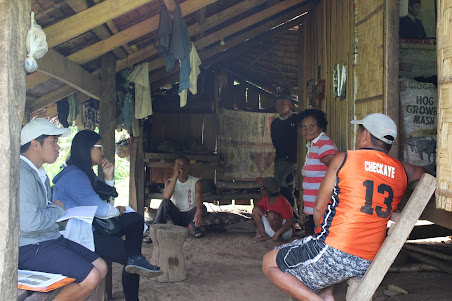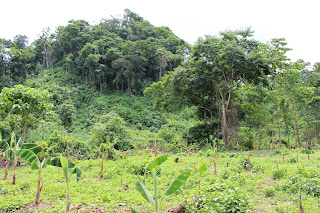The Triadic Relationships in Vernacular Landscapes of the Mangyan Iraya Tribe
The Triadic Relationships in Vernacular Landscapes of the Mangyan Iraya Tribe
The way an individual acquires his or her conception of landscape requires unveiling their thought process. To elucidate this, the researcher constructs a structure among the five landscape domains between the individual, the ancestral past, and the world around them. This process was inspired by Howard Murphy’s ‘reproduction of the ancestral past in the landscape’ (Murphy, 1995). Here, Murphy emphasized the influence of actions and structure-based both on social theory and Aboriginal metaphysics as the central analysis (Murphy, 1995). His main argument is that the interaction with the landscape is part of a process, and the Aboriginal society is reproduced by the component of its cultural structure (Murphy, 1995) which are results or parts of the processes of human-landscape interaction. This concept goes similar to the Mangyan Iraya tribe. The deliberate emphasis on the interdependence of the triadic elements showed a process of transforming ‘process’ to human life to eventually leading to a reproduced landscape. While this theory came to being driven by a Western concept, the process of shaping the Mangyan Iraya’s vernacular landscape also showcased repetitive mutually interdependent components of landscape reality---human, the ancestral past, and the world around them. To support the level of reality represented in the study, the context of historically based social relations of Bourdieu (1977) and Giddens (1979) was adapted (Bourdie, 1977, Giddens, 1979). For example, Murphy emphasized that culture and society may be best conceptualized as mutually interdependent, culture being a co-determinant of the social-cultural trajectory (Murphy, 1995). In this study, the level of reality associated in the Mangyan Iraya’s vernacular landscape is a resultant process of socio-cultural reproduction with emphasis on the influence of ancestral past.
 |
| The everyday morning view of Cauayan Family, one of the first three inhabitants in Sitio Calomintao when the community was first founded in 1910. |
Ancestral Past: Paniniwalang Iraya as a Structure Influencing the Landscape. Paniniwalang Iraya or belief in Apo Iraya played a crucial role in the formation of the society, human relations, as well the tribe’s vernacular landscape. Paniniwalang Iraya is a structure that has been lived and a result of consequences in and of the past. This belief system was adjusted, reproduced, and adapted to the tribe’s way of life. However, the transformation of such belief systems have also become interdependent by the tribe’s way of life; be it shaped by societal challenges, the discovery of new landscape management, or the influence of external factors such as the burgeoning association of outside race often with their own belief system. For example, a huge stone found on top of a mountain is believed to be a home for spirits, the turbulent discharge of spring water is conceived as an active space where many spirits roam, or an eerie sound during the wee hours inside a sacred virgin forest meant a presence of malevolent spirits asking humans to vacate the space. According to Murphy, such conceptions are results of ancestral pasts that later influence the way how space is used, associated with other spaces, or simply mentally conceived and interpreted. Through time, these landscape elements were ‘flavored’ with connotations that ancestral beings possess, inhabit, or associate such elements. The current vernacular landscape of the Mangyan Iraya now becomes a collection of these associations with ancestral beings. This is also why it is inherently impossible to generalize the cosmology of one’s existing tribe. The collection of belief systems embedded in the landscape and its elements change through time that continuously shape and re-shape new identities in the landscape.
Humans: Mangyan Iraya as Stewards of Ancestral Land. The Mangyan
Iraya, at any particular point of the tribe’s history, stands as the prime
stewards of their ancestral lands. An individual interacting with his or her
landscape is another structure in conceiving a vernacular landscape. In an
ethnographic study of Harold Conklin, the cultivation of kaingin farms involves the determination of environmental
conditions shaped by the cultural modification of the forest lands or a hill
(Conklin, 1954).
Conklin carefully documented the step-by-step process of harboring a piece of
land into a kaingin farm conceived as interrelations of local cultural and
natural phenomena (Conklin, 1954)..
The process of following a locally determined, well-defined pattern of this
traditional farming requires hard physical labor but a large labor force is not
required (Conklin, 1954).
A Mangyan Iraya, particularly men, carefully studies, manages and shapes his
kaingin farm influenced by the notion that this farm is like a pregnant woman.
Men plant the seed and women carry his child. This gender-based conception of
kaingin farms are resonated and reflected by other neighbor race like the
Hanunuo Mangyan (Miyamoto, 1988).
This locally inherent conception of space in a landscape represents something
that helps the Mangyan Iraya produces their world, both physically and
metaphorically. The flow of action may then be fixed for some time and becomes
repetitive every agricultural calendar, but the fact of its transmission to the
landscape forms a structure that exists outside the ancestral world. Through
this, one can argue that the interpretation of vernacular landscape through the lens of a local is also devised by his own personal understanding shaped by the
culture one grew up in.
The transference of
knowledge through saling-kwento (shared-stories)
also play key roles in forming a landscape. For example, the construction of bahay-kubo, the Mangyan’s traditional
house requires the accumulation of natural resources in the forest and mountains.
As part of shared heritage and traditional knowledge, the Mangyan Iraya locates
the best possible locally-sourced material for their houses. This continuous
and repetitive process of sourcing these materials in specific parts of the
forest creates forms and changes in the landscape, be it in structure or
ecological functions. Journeyed on the significance of traditional knowledge,
the Mangyan Iraya doesn’t fit their systems thinking in the box (in this case,
their landscape), rather, their knowledge work around the box. This protrudes
its long-perused sustainable landscape management. It is also through the
harboring and enriching of knowledge systems that the ancestral world meets the
physical human world (Murphy, 1995).
In other cultures, the systematic association between landscape, ancestral
beings, and social groups are clearly expressed in artistic systems (Murphy, 1995). Oftentimes, the uniqueness of each place
is signified by the unique characteristics of its designs (Hirsch, 1995). or
the level of articulation of a cultural art form. From this study, the
ecological management and transference of traditional knowledge systems are
just two of the close associations where cultural belief, personal conception of
the landscape based on the process and extent of interaction, and
cross-reference of mythical representation (e.g Apo Iraya) coalesce. These
ecological zones are merely the Mangyan Iraya’s true ‘artform’ that is uniquely
Mangyan, hence, a landscape identity. Invariably, some characteristics of these
Indigenous art forms overlap with other complex referential cultural artistic
expressions. However, this study refrained to be submissive from the fact that
any landscape changes, be it for ecological management or simply cultural
intentions, it is again evident to trace the association of the Mangyan Iraya’s
psychological influences to exist in different states that resulted to
different changes pressed in the landscape.
 |
| Kuya Paulo Cauayan carefully explains the process of planting a special rice variety the tribe uses that doesn't require watering. |
References:
Murphy, H (1995) Landscape and the
Reproduction of the Ancestral Past. The
Anthropology of Landscape: Perspectives on Place and Space. Oxford
University Press. Walton: New York, 187
Bourdie, P (1977) Outline of a Theory of
Practice. Cambridge: Cambridge University
Press
Giddens, A (1979) Central Problems in Social
Theory: Action, Structure and Contradiction in Social Analysis. Berkely,
California: University of California
Press
Conklin, H (1954) An Ethnoecological Approach
to Shifting Agriculture. New York Academy
of Science, Ser. 2, 17, 126
Miyamoto, M (1988) The Hanunuo-Mangyan,
Society, Religion and Law among a Mountain People of Mindoro Island,
Philippines, National Museum of
Anthropology, 32
Hirsch, E (1995) The Anthropology of
Landscape: Perspectives on Place and Space. Oxford University Press. Walton:
New York, 31





Comments
Post a Comment